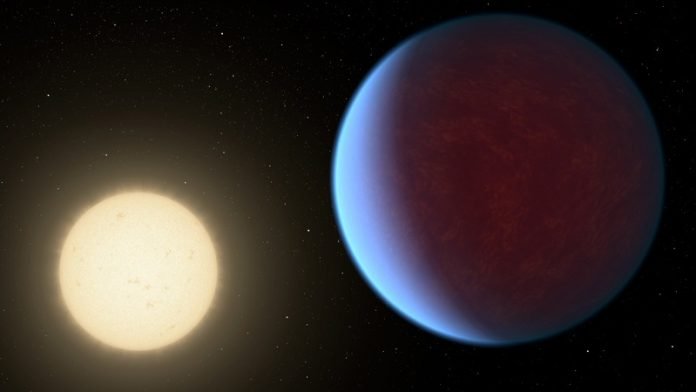
In this era of exoplanet discovery, astronomers have found over 5,000 confirmed exoplanets, with thousands more awaiting confirmation and many billions more waiting to be discovered.
These exoplanets exist in a bewildering spectrum of sizes, compositions, orbital periods, and just about every other characteristic that can be measured.
Learning about them has also shed light on our Solar System. We used to think of it as an archetypal arrangement of planets since it’s all we had to go on.
But now we know we might be the outlier because we have no Super-Earth.
Super-Earths are a class of planets that are common around other stars. They’re defined by mass alone, between 2 to 10 Earth masses.
Even though planet-hunters have found over 1500 of them, our Solar System doesn’t have one.
Since our Solar System lacks one of these representative types, it’s difficult for planetary scientists to understand the Super Earths in other systems.
Our Solar System’s architecture is quite a bit different than what astronomers see around other stars, too. Systems like Kepler-11 have multiple planets in compact systems on long-term stable orbits much closer to the star.
Interactions between planets this tightly packed should contribute to orbital instability, but Kepler-11’s planets have the potential to be stable for billions of years.
The smallest planet in the system, Kepler-11 f, is still 2.5 times more massive than Earth.
Other systems like HD 20782 have planets with extreme orbital eccentricities. HD 20782 b has one of the most eccentric orbits known.
Its eccentricity is 0.97, extremely high since an eccentricity of 1.00 is an escape orbit. (For comparison, Earth’s eccentricity is 0.016, where 0 is a circular orbit.) As a result, HD 20782 b experiences wild temperature swings as it travels from the inner solar system to the outer system on its 585-day orbit.
One experienced planetary researcher wanted to know what would happen if our Solar System did have a Super-Earth. How would it change our Solar System? Would a Super-Earth bring our Solar System more in line with some of the other systems we see in the Milky Way? Would our Solar System even be recognizable?
To find out, he created a simulated Super-Earth in a simulation of our Solar System.
His name is Stephen Kane, and he’s a Professor of Planetary Astrophysics at the University of California. The paper is “The Dynamical Consequences of a Super-Earth in the Solar System,” and Kane is the sole author. The paper hasn’t been peer-reviewed yet.
In his paper, Kane points out our Solar System’s planetary size/mass gap and what it means for researchers. Without a Super-Earth, which fits in between Earth and Neptune’s mass, it’s challenging to place our system in context. It’s difficult to model how these planets form and what their composition might be.
There could be multiple reasons why our system has no Super-Earth. The early migration of Jupiter and Saturn may have played a role by gobbling up mass that could’ve accreted onto Earth or Mars and turning them into Super-Earths.
Without our own Super-Earth to study, researchers are left with a lot of questions. “Even so,” Kane writes, “it is useful to investigate the dynamical consequences of additional planetary mass within the Solar System in order to constrain current formation theories and study the implications for general planetary system architectures.”
Detailed computer models and simulations are an important part of astronomy, and they’re becoming more detailed and powerful as time goes on.
Researchers vary the inputs to see how things like Solar Systems and planets form and behave under different conditions. In this work, Kane placed a Super-Earth in our Solar System to see what would happen.
“In this paper, we provide the results of a dynamical study that places an additional terrestrial planet in the mass range 1–10 Earth masses and semi-major axis range 2–4 AU within the current Solar System architecture,” Kane writes.
Kane added planets with masses between 1 to 10 Earth masses in steps of 1 Earth mass. He placed the planet at different starting positions in circular orbits. The orbits were co-planar with Earth’s, and the semi-major axis ranged from 2 to 4 astronomical units (AU) in steps of 0.01 AU.
“This resulted in several thousand simulations, where each simulation was allowed to run for 107 years, commencing at the present epoch and an orbital configuration output every 100 simulation years,” Kane explains.
The simulations showed that the inner planets were more susceptible to instability from the addition of a Super-Earth than the outer planets were. “The broad region of 2–4 AU contains many locations of MMR (mean motion resonance) with the inner planets that further amplify the chaotic evolution of the inner Solar System,” the paper states.
“Chaotic evolution” is an understatement. The addition of a Super-Earth changes the relationships between the planets and changes the entire architecture of the inner Solar System. “For this example, the orbits of all four inner planets become sufficiently unstable such that they are removed from the system before the conclusion of the 107-year simulation.”
Poor Mars only made it halfway through the simulation before being ejected. Mercury only made it one-third of the way through the simulation before interactions with Venus and Earth, and their increasing eccentricity, imparted angular momentum into Mercury’s orbit, driving it away.
In another run of the simulation, Kane placed a Super-Earth with 8 Earth masses at a distance of 3.7 AU. That led to slight initial increases in Earth’s and Venus’ eccentricities which then, combined with Jupiter’s influence, perturbed Mercury’s orbit so much that it was again ejected quickly.
Mercury’s catastrophic removal then changed Earth and Venus by injecting angular momentum into their orbits.
“This results in a substantial periodic evolution of their orbits, with both high and low-frequency variations in their eccentricities,” Kane writes.
Mars’ orbit is relatively unaffected in this scenario, though its eccentricity “undergoes high frequency oscillations due to interactions with the outer planets.”
The outer Solar System also changed, though not as severely. When the simulation placed a planet with 7 Earth masses at 3.79 AU, not much happened at first. But eventually, there’s a dramatic change.
The Super-Earth’s orbit changes, and its semi-major axis reaches as far as 30 AU. After about 4 million years, the Super-Earth is ejected from the system. Its ejection transfers angular momentum, and that has a “substantial effect on the eccentricities of Saturn, Uranus, and Neptune,” Kane explains.
In another simulation, the injected Super-Earth also had 7 Earth masses, and the AU changed only slightly, from 3.79 to 3.8. The Super-Earth was ejected again, and Jupiter and Saturn experienced increased eccentricity. The slight change triggered the loss of Uranus, too.
Kane performed several thousand runs of the simulation and depending on the parameters, some of the inner planets were ejected, as was the implanted Super-Earth. In other architectures, the icy giants were also ejected. But ejection is only one outcome, albeit the most extreme.
The simulations showed that the presence of a Super-Earth can make the orbits of the other planets more eccentric. That can wreak havoc on a planet’s climate, as the temperature swings wildly depending on where the planet is in its eccentric orbit.
“These interactions result in large amplitude oscillation of Venus and Earth orbital eccentricities, creating Milankovitch cycles that may potentially influence the long-term climate of these planets,” Kane concludes.
There are many Super-Earths out there, and it’s an open question how strongly their presence influences habitability in other systems. If this study is any indication, it’s a question that needs to be examined. “The dependence of planetary climates on orbital interactions with super-Earths will require further atmospheric data and modelling to determine if the presence of such planets (or lack thereof) can preferentially lead to eccentricity-driven climate effects,” the author explains.
In prior decades, astronomers used our Solar System’s architecture to develop models of solar system formation and architecture. But now we know that our Solar System is not representative of what’s out there, especially when it comes to Super-Earths. The difference might stem from how the giant planets migrated.
“In particular, these giant planet migration events may have influenced the terrestrial planet formation processes in the inner Solar System and truncated the formation of the most common type of planet thus far discovered: Super-Earths,” the paper states.
The Grand Tack Hypothesis shows how Jupiter formed at 3.5 AU, migrated inward to 1.5 AU, then back out to 5.2 AU. The King of the Planets moving through the Solar System like that would’ve affected everything around it.
It could’ve created a collisional cascade between objects in the inner Solar System, driving material into the Sun that could’ve formed a Super-Earth. Some researchers think that our system did have a Super-Earth in the distant past that perished in the Sun.
Kane calls our lack of a Super-Earth a ‘double-edged sword.’ On one hand, we have no opportunity to study a Super-Earth as closely as we can study terrestrial planets, gas giants, or ice giants. But the presence of a Super-Earth could have changed the Solar System completely and could’ve potentially been catastrophic for life.
“Our results reveal the dynamical fragility of our existing planetary configuration, allowing a more detailed examination of this configuration within the broader context of planetary system architectures,” Kane writes.
The work’s primary purpose is to enable comparisons between our own ‘oddball’ system and the plethora of Super-Earth-containing solar systems out there.
“The study of the orbits with these systems, both from individual and statistical points of view, will
demonstrate the true consequences of sharing dynamical space with a super-Earth planet,” he concludes.
Written by Evan Gough.
Source: Universe Today.



